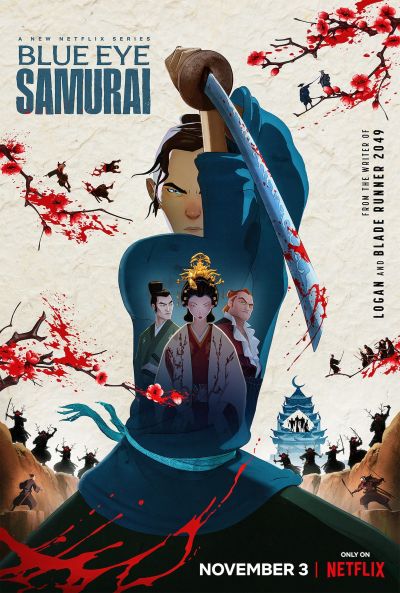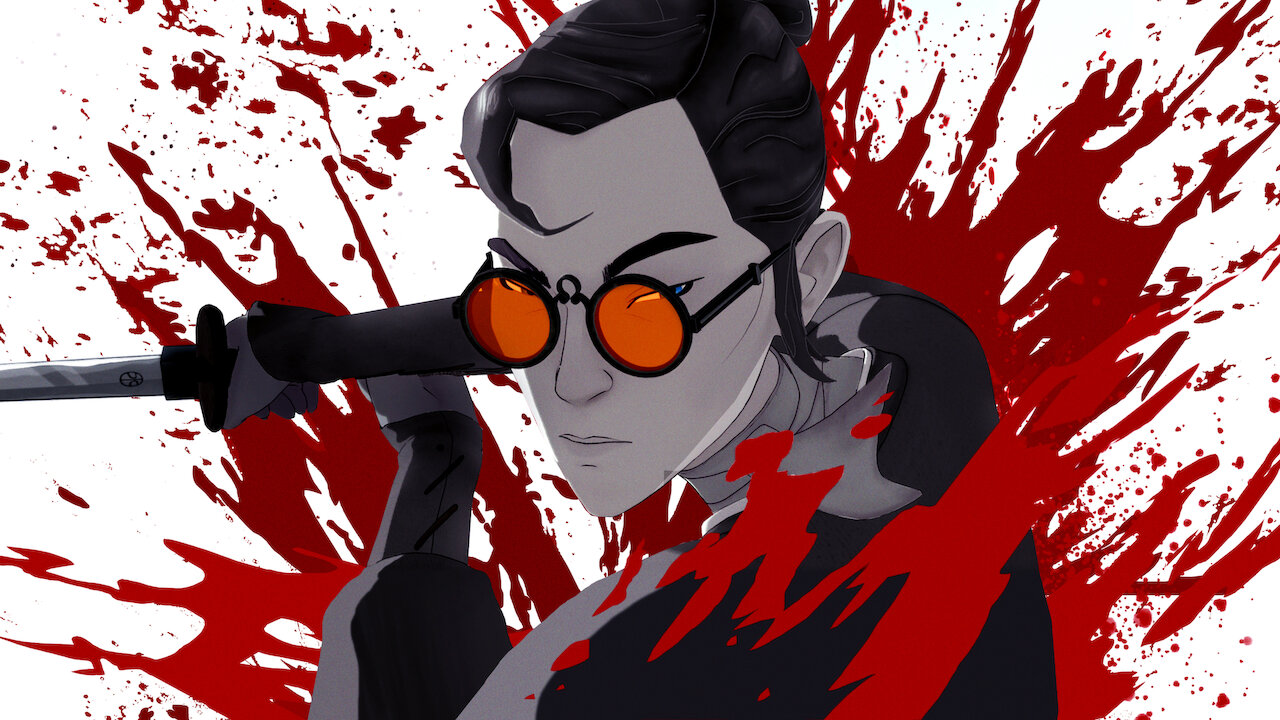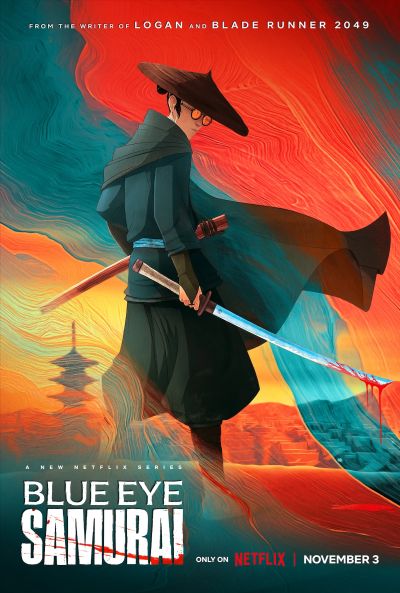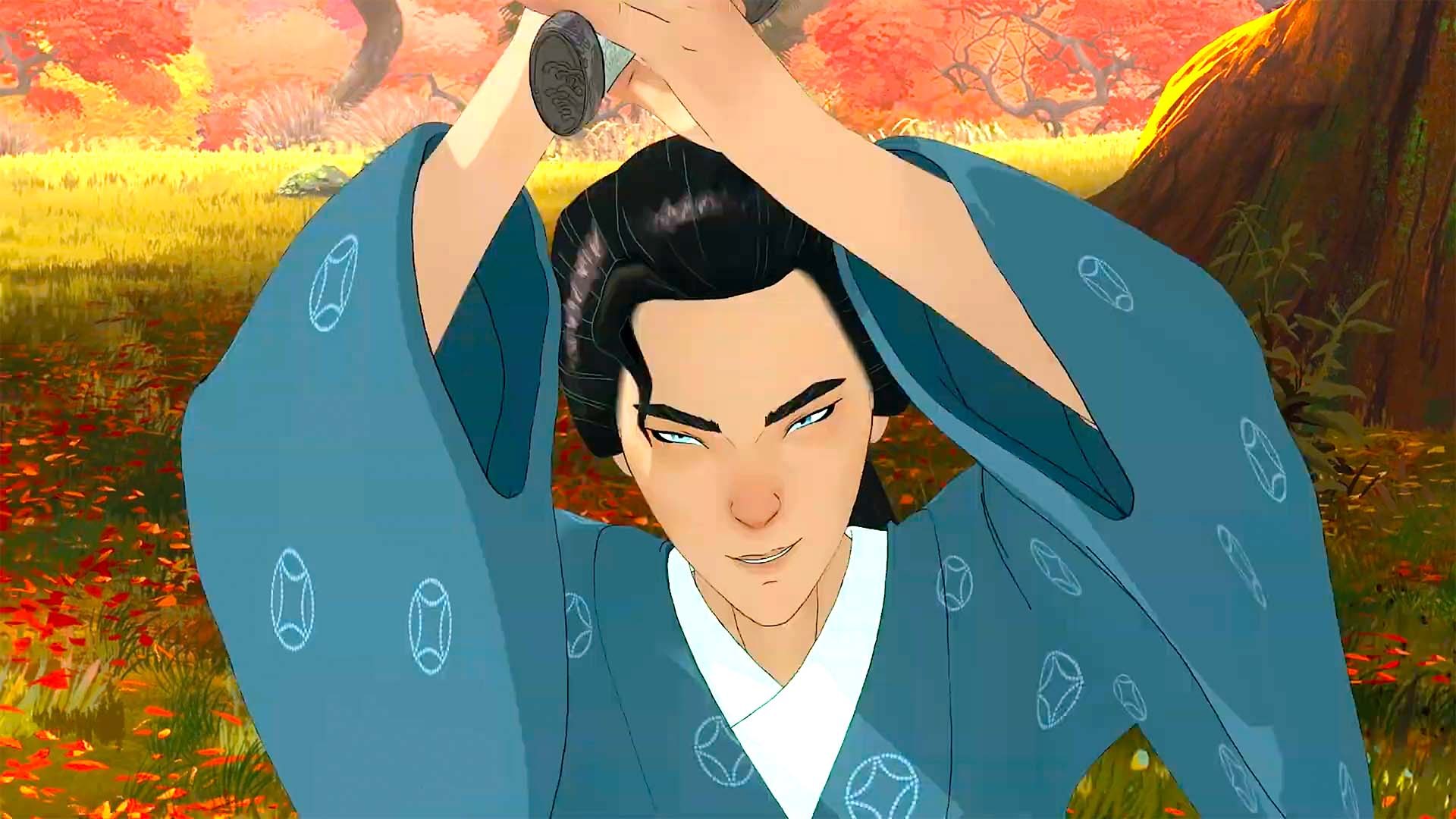 Jim: ★★★
Jim: ★★★
Dieter: ★★★★
“You can’t die. You don’t know how.”
Plot. Mizu (Erskine) has a grudge. She’s a mixed-race young woman living in 17th-century Japan, a position which leaves her at the bottom of society. But she has dragged herself up to become an onna-musha, a warrior with ferocious sword skills, courtesy of Master Eiji (Cary-Hiroyuki Tagawa), the blind swordsmith who raised her. Now, she’s on the hunt to take revenge on the man she believes is her father, Abijah Fowler (Branagh). He’s an Irish smuggler, who is upsetting the delicate balance of Japanese society, closed to foreigners, by importing firearms. He’s involved in planning a coup to overthrow the current shogun.
[Editor’s note: the original plan was for Dieter and I to review it independently, then combine the two pieces. But Dieter went into rather more detail! So most of what follows is his opinion, with my thoughts sprinkled as garnish, in italics]
I have to admit my opinion on this show has changed a couple of times while watching it. First, there was the enthusiasm of a Japan-based-action series with a female main character. After that I thought about the “wokeness” of the show (after all, it’s Netflix), something that hardly can be overlooked. And finally, I recognized the strong effort that went into the storytelling, the visual beauty, and small details of the show and realized that while definitely a “woke” story, these elements are neither too strong nor too dominant to destroy the genuine pleasure I had when watching it.
I liked this, but it’s probably fair to say I didn’t love it. I tend to have a blind-spot with regard to animated action. Personally, I find it’s a medium that dilutes the intensity of fight scenes, because it applies a distancing effect to it. I’m always aware that I’m watching drawings or pixels beating the heck out of each other, which is intrinsically going to be less impressive than people “really” doing so. If this had been live-action, and equally gory, it could have been awesome. There’s also a weird visual choice here in that Mizu’s nose is typically shadowed. This has the unfortunate effect of making her look to me either as if she has a bad head cold, or if she is a habitual alcoholic.
 But first things first: despite its title and the location (Japan in 1657 in the Edo era) Blue Eye Samurai is – an American product, so certain allowances have to be made. While I do love a story of female persistence, this 8-part show pushes the limits of believability. We have to accept that, at a time when foreigners are forbidden to be in Japan, not only there is such a person living there, but also this man fathered a daughter. This means she is half-Caucasian, half-Japanese and therefore considered a “demon”, harassed by pure-blood Japanese who have never seen such a stranger in their country. She will then become a trained “samurai” – quotes used advisedly, as we’ll see – with the appropriate sword skills.
But first things first: despite its title and the location (Japan in 1657 in the Edo era) Blue Eye Samurai is – an American product, so certain allowances have to be made. While I do love a story of female persistence, this 8-part show pushes the limits of believability. We have to accept that, at a time when foreigners are forbidden to be in Japan, not only there is such a person living there, but also this man fathered a daughter. This means she is half-Caucasian, half-Japanese and therefore considered a “demon”, harassed by pure-blood Japanese who have never seen such a stranger in their country. She will then become a trained “samurai” – quotes used advisedly, as we’ll see – with the appropriate sword skills.
It’s a stretch, though still in the reign of possibility, since there have been, real swordswomen in Japan. That woman then going on a rampage, hell-bent on revenge for… well… her own creation? This does not make much sense to me. After all, should we not all be happy we exist? But then, my own life, like most, has been peaceful and harmonious. In contrast, the main character, Mizu, has led a life of misery, constantly been harassed, pursued with hatred, endangered and betrayed. It’s not difficult to imagine, if you grew up that way, you would sooner or later start to hate the man responsible for your very existence. Though strangely, she doesn’t seem to hold a similar grudge against the mother who gave birth to her,
Mizu’s path leads her to Ringo, the son of a innkeeper, who has no hands (remember, this is Netflix!). After being saved by her, he becomes her servant. There’s also Taigen, a samurai-in-training, who once lived in the same town as Mizu and almost succeeded in killing her as a child. After she beat him in battle, he feels his honour is insulted and follows Mizu to challenge her to a rematch. But his revenge has to wait. A further complication arises in Japanese noblewoman Akemi, who is in love with Taigen and would like to marry him. Though her father has other marriage plans and Taigen is not ready to marry her until he has regained his honor. None of them know (yet) that Mizu is a woman. And as Mizu mercilessly pursues her path of revenge, Ringo and Taigen become her allies, with some indication of a mutual attraction between Mizu and Taigen.
Blue Eye Samurai is a French-American animated show by Blue Spirit for Netflix, created by Michael Green (the screenwriter for Logan and Blade Runner 2049) and Amber Noizumi. They were inspired by their daughter, who was born 15 years ago with blue eyes. Noizumi spoke about how she, herself biracial, wondered what it would have been like to lived as a biracial person in 17th-century Japan, when Japan’s borders were closed to the outside world and strangers from abroad would have no chance to be accepted in society. Another, unconfirmed inspiration might be British navigator William Adams who travelled to Japan in 1600, and was called “the blue-eyed samurai”. He also inspired the ever-popular series Shogun, which Netflix just remade. What a coincidence.
Other influences, according to Noizumi, were movies such as Kill Bill, Lady Snowblood, and… Yentl, Barbara Streisand’s musical about a Jewish woman who wants to study and has to take on a male identity. It has been confirmed by Noizumi that Mizu was inspired by Clint Eastwood’s break-out Man with No Name role in the famous Dollars trilogy by Sergio Leone, This fits, because the show often reminded me less of a typical Japanese jidaigeki (historical drama) or chanbara (sword-fighting movie with a historical background), but more a Western in disguise. If the mix between East and West was intended, whether this makes it “the best of two worlds” or a travesty is up to you. But it’s not really the first of its kind, considering Tom Cruise’s The Last Samurai.
I personally don’t like it when words like “emancipation” or “discrimination” are thrown around in relation to a show mainly meant to entertain. But in this case, they are justified given the very basis of the show, in medieval Japan. This setting is different to current Western countries, being one with a mostly homogeneous population, traditional conservative values and what feminists nowadays like to call “patriarchal”, as a background for a story of female emancipation and racist discrimination. You may question what “woke propaganda” Netflix is tossing at an innocent viewer this time. But it’s a relief that any messaging comes, not in heavy-handed preaching, as is typical for many Netflix shows, but mostly carefully integrated into the show, rather than feeling like they were bolted on.
 The show certainly ticks all the diversity check-boxes with its characters. We have a biracial female who taught herself everything, a repressed (though in the context of the era “spoiled” might be more accurate?) lord’s daughter, a helpful assistant born with no hands, a blind sword-maker, while an old white man is the perverse, cruel villain, and women have no say in society, serving as servants or prostitutes. Did I forget anything? Despite it all, this feels acceptable given the time and place in which the story occurs.
The show certainly ticks all the diversity check-boxes with its characters. We have a biracial female who taught herself everything, a repressed (though in the context of the era “spoiled” might be more accurate?) lord’s daughter, a helpful assistant born with no hands, a blind sword-maker, while an old white man is the perverse, cruel villain, and women have no say in society, serving as servants or prostitutes. Did I forget anything? Despite it all, this feels acceptable given the time and place in which the story occurs.
As noted, in choosing this kind of story, time and place, the creators often stretch the limits of believability. In particular, with Akemi, the daughter of a powerful lord who wants to marry her to the son of the shogun. She is in love with Taigen, so absolutely resists that idea. Akemi comes across the entire series as enormously stubborn, resisting advice and always wanting to get her way. I have to shake my head in disbelief, knowing that the idea of “marriage for love” was in those times rare both in Japan and Europe (Historians say the idea of what we call today “romantic love” was born around 1850). People married due to sharing social class, to keep property within a circle of families, or because their business-partnered parents decided so, sometimes even before they were born.
Even more unbelievable for the time, is the idea a Japanese woman would have been allowed to voice her wishes or opinion in the blunt manner depicted here. Quite honestly, I think if any woman would have behaved so disrespectfully to an older man, giving strong, vocal objections or even slapping the shogun’s son, she would have immediately been beheaded or drowned in the nearest pond. The wish of the creators to have another strong female character in the show backfires here. Akemi is what you would expect a modern, Western young woman to be, not a Japanese woman from the Edo era. This is fan-fiction at best, bad research at worst.
Probably my least favourite aspect was this significant side-plot involving noble samurai Taigen (Barnet), and his true love, the Princess Akemi (Branda Song), who is about to be married off against her will. Neither of those characters seemed significant, and it felt like this sometimes became an excuse for male-bashing. Brothel madam Kaji (Ming-Na Wen) was the worst for that: look, nobody is keeping you a prostitute. Get out of the profession or quit complaining about your customers. Oh, and if men are bad, white men as embodied by Fowler are the absolute worst.
A word of warning to the uninitiated. The show does not hold back in the depiction of violence. The slicing-off of extremities sometimes made me wonder if the victims’ bodies were made out of styrofoam, and I also found a bit excessive, the arterial blood spray. How many litres does the human body contain? The same goes for sexuality, though less often. I personally have seen more extreme things, but this is Western animation, and the audience may not be quite prepared for the graphic content. But I guess anyone going to watch the show would probably know beforehand it is not a show for children. You wouldn’t expect kid-friendly content from an Akira Kurosawa samurai movie, wouldn’t you?
 This was not a problem for me. Indeed, I would have been disappointed had it been any other way! The “garden hose” approach to blood has long been a mainstay of Japanese cinema, certainly back as far as the early seventies and the Lone Wolf & Cub films – a staple of Western VHS stores under the title of Shogun Assassin. Realism isn’t a factor, and this is an area where animation can really push the pedal to the metal, being unconstrained by the limits of latex and Karo syrup.
This was not a problem for me. Indeed, I would have been disappointed had it been any other way! The “garden hose” approach to blood has long been a mainstay of Japanese cinema, certainly back as far as the early seventies and the Lone Wolf & Cub films – a staple of Western VHS stores under the title of Shogun Assassin. Realism isn’t a factor, and this is an area where animation can really push the pedal to the metal, being unconstrained by the limits of latex and Karo syrup.
Ah, yes… samurai, that’s a key word: after all, it’s in the title and is mentioned several times. I should stress here, Mizu definitely is no samurai by the traditional definition. He would usually act in service of a daimo, a feudal landlord serving the shogun. This usually comes with certain obligations and behaviour that would be seen as a code of honor. Mizu quite definitely doesn’t fit the description. However, many of Kurosawa’s “samurai” don’t either, including The Seven Samurai or the character Toshiro Mifune plays in Yojimbo and Sanjuro (which, cycling back, served as inspiration for Eastwood’s Man with No Name). But the writers of the show were really smart, and address it within the story. When Ringo complains she doesn’t act like a samurai would, she turns and angrily shouts: “I never said I am one.” It’s a sign of well thought-out screenwriting, and I like it very much. Kudos to the storytellers: now, will they make the show eventually deliver what the title promises?
I was less impressed with the music. More than once the people responsible seemed to think, “As long as it’s cool, everything is fine” – an attitude I personally don’t agree with at all. For example, in a training montage of Mizu, the famous “Battle Without Honor Or Humanity” by Tomoyasu Hotei plays. Sure, a cool tune from a Japanese composer. But it’s modern music and – though first used somewhere else – so closely associated with Kill Bill, it really felt like a misstep. Other popular pieces, e.g. by the Black Cats or Metallica, have even less justification. You tell a story in 17th century Japan, please apply music that fits the time period. And partly the show feels like a check-list of everything you ever heard or saw in the West about classic Japanese culture, from bunraku (classical puppet theatre) through geishas, samurai, Zen-like philosophy, sword-making, kimonos, calligraphy and so on and on. You name it, they have it.
With regard to the cultural depictions, I wasn’t happy with the fact these obviously Japanese characters were speaking in English, to the point I even checked for a Japanese dub option (no luck). It felt like the creators sent out a casting call for any Hollywood voice talent with somewhat Asian origins, e.g. Song, born in California to Thai parents, and having Kenneth Branagh putting on a dodgy Irish accent doesn’t help. Were all genuinely Celtic actors unavailable?
Episode 6 really knocked my socks off. It played virtually like a computer game: think Tomb Raider’s Lara Croft going through different levels of the game, plus elements from Resident Evil for good measure. I’m not saying it was bad. so much as unexpected. It’s also a point when it became harder to suspend my disbelief concerning Mizu’s abilities. I mean, how many people can you still fight, after one of your feet gets perforated? Or fighting a dozen-plus armed men without a weapon? Or carrying a man on her back, hanging from her sword on a stone wall, then climbing with said sword in her mouth (!) to safety on higher ground? Are we really sure she is not the child of a supernatural monster? I’m willing to believe this woman is exceptional, but this was a bit much. Mizu gets dangerously close to the superheroes of popular comic-book movies who can do anything, and usually do.
Part 6 was my favourite of the entire show, because it removed all the extraneous elements (hello, Taigen, Ringo and Akemi!), leaving it a blow-dart episode – all it had was point, simply Mizu fighting her way inexorably towards her goal. Which was what I came here to see, frankly.
What saves the character’s depiction again and again, is the makers never make it easy for her. She bleeds a lot over the course of the story. Mizu is shown making mistakes, and is not a hero since, as much as you sympathize with her goal, it is in the end selfish. I attribute the fact she survives this season to her remarkable physical skills, absolute die-hard dedication to her self-set cause, the help of her (very often smarter) allies and an enormous portion of luck. Which… works for me, though I’d have wished for a bit more realism in a show that explicitly is not fantasy. What is impressive is the visual style. A lot of work went into the landscapes, the backgrounds, and probably researching how ancient Japanese houses, buildings and temples looked. There are a lot of little details that you may overlook when watching the show for the first time. Also, as expected, the voice performances by actors such as Erskine, Takei, Branagh, Tagawa and many others are excellent.
I agree, the animation was great, especially in the action scenes, which were probably as good as anything I’ve seen this side of a Miyazaki movie. Fluid, and assembled in a way that certainly seemed cinematic. It was often easy to forget you were watching animation, and that’s close to the highest praise I can give the medium. Plot-wise, the main storyline was also excellent. I loved the fact that Mizu is single-mindedly focused on her revenge. That it might help avoid the Shogun being overthrown is utterly irrelevant to her.
 It must be said that Mizu herself is a character ‘work in progress’. As mentioned, less a hero, than driven by years of abuse, mistreatment, non-acceptance, anxiety and sheer hatred. I guess any little boy with red hair and glasses who was harassed in class can understand her. The feeling of not being part of society or a group, of being rejected due to just being how you are, is something many people will identify with. Though again: does it justify a violent rampage on a merciless one-woman war against the person that fathered you? Hardly. The feeling is softened by the fact Abijah Fowler, who may be her biological father, is a real piece of abhorrent trash. He is a disgusting, almost inhuman, pervert, who deserves his just deserts.
It must be said that Mizu herself is a character ‘work in progress’. As mentioned, less a hero, than driven by years of abuse, mistreatment, non-acceptance, anxiety and sheer hatred. I guess any little boy with red hair and glasses who was harassed in class can understand her. The feeling of not being part of society or a group, of being rejected due to just being how you are, is something many people will identify with. Though again: does it justify a violent rampage on a merciless one-woman war against the person that fathered you? Hardly. The feeling is softened by the fact Abijah Fowler, who may be her biological father, is a real piece of abhorrent trash. He is a disgusting, almost inhuman, pervert, who deserves his just deserts.
Interestingly, the final fight between Mizu and Fowler is the catalyst for the fire of 1657 which devastated Edo (today’s Tokyo). Perhaps the message here is, if you follow only your own egotistic trail – Mizu’s wish for revenge and Fowler’s to take over Japan – you risk turning into a destructive force that causes more harm than good. I hope Mizu might realize her thirst for revenge is not the best motive, but rather acting to prevent the mayhem Fowler and his people would bring to the world if allowed to run it. This would make Mizu a real heroine and earn her my respect. Perhaps indicators for such a development can be spotted when Mizu decides to save her “frenemy” Taigen from death. If the show is willing to follow this developing character trait, it could evolve into something very beautiful and extra-ordinary. We will see.
It ends on something of a cliff-hanger, without much resolved. Yet where it’s going has me genuinely interested, and it’s quite possible the (already announced) second season may end up addressing most of the issues. In particular, some of the more annoying characters look likely to be left behind!
In a time where female protagonists get everything they need or want on a platter, without having to do the hard work, make difficult decisions or sacrifices, a character like Mizu feels different. She has character flaws, feels pain and has to become a better person, not just to achieve her own goals, but better the world around her. That is what popular fiction needs right now, and Hollywood screenwriters should take notice. That’s how you should write a character: flawed, not perfect. If your character can already do everything and is perfect you end up with boring, bland characters like Rey or Captain Marvel. So, while still a bit too superwoman and “Xena-ish” for me, Mizu is a big step in the right direction. Despite some complaints, the show as a whole exceeds the large majority of current female-centered TV and films. I hope it might inspire other producers to learn from its example. This is how you do female empowerment right, without hitting both sexes of your audience on the head with messages or propaganda.
Creators: Amber Noizumi and Michael Green
Star (voice): Maya Erskine, Masi Oka, Kenneth Branagh, Darren Barnet




